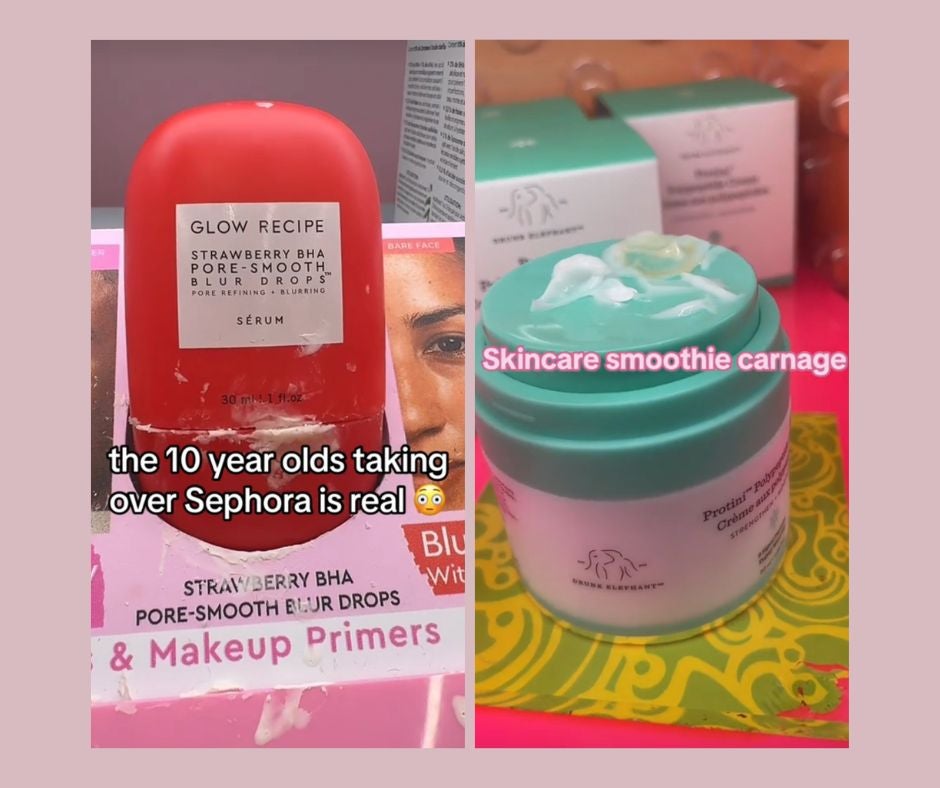The Independent's journalism is supported by our readers. When you purchase through links on our site, we may earn commission.
‘Sephora Kids’ are TikTok’s latest villains - but their parents aren’t the only ones to blame
Ten-year-old girls have taken over Sephora, and adults are not happy. Meredith Clark takes a look at the ongoing ‘Sephora Kids’ phenomenon, and how influencer culture and the minimising of tween spaces may be to blame


When college student Chloe Grace took to TikTok to share her recent shopping experience at Sephora, she inadvertently sparked a viral phenomenon known as “Sephora Kids”. It all began just days after the Christmas holiday, when she asked her thousands of followers if they’ve also noticed their local Sephora stores being overrun with tween girls.
“Has anyone else noticed that every time you go into Sephora now it’s just all little girls?” she began the video, which has been viewed more than three million times.
Chloe wasn’t the only Gen Z shopper to point out this recent uptick in 10-to-12-year-old girls shopping at major American beauty supply chains like Sephora and Ulta. TikTok user Megan Lacey went viral when she detailed her recent Sephora encounter with a few tween girls “taking up every single section” in the store. Just days later, TikTok user Dane recalled “a group of three young girls” were “rude” to him at a Sephora, while Kiley Ryan claimed young shoppers were being “disrespectful” to Sephora customers and staff.
Tween girls are invading Sephora, and some adult shoppers (and employees) are not happy about it.
Picture this, you’re the tender age of 11 and you just received a boatload of cash from your parents for the holidays. Much like the female influencers on your TikTok For You Page (in this scenario, it’s 2024), you decide to spend it all on a Sephora “haul” - buying up products that your favourite content creators, like Alix Earle or Meredith Duxbury, have used in their “Get Ready With Me” videos.
We’ve all been there before, feeling overwhelmed with excitement to finally purchase yourself the items on your Christmas wish list that your parents had glossed over. Only for some of us, our go-to stores for post-holiday doorbusters were the many tween-focused retailers of years past, such as Delia’s, Claire’s, or Justice (RIP, Limited Too).
The phenomenon that is Sephora Kids has highlighted a pivotal change in tween culture, where retail stores that cater to young girls are out and pretending to be an adult is in. However, it seems that millennials and Gen Z-ers aren’t just simply annoyed by the presence of unaccompanied children running wild in the hallowed black and white halls of Sephora. Not only are young girls allegedly being “rude” to customers and staff and making “skincare smoothies” with display products (more on that later), but it’s the beauty and skincare products they’re purchasing that have really disturbed the internet.
According to eyewitness accounts on TikTok, the most popular brands among Generation Alpha - the generation of people born between 2010 and 2024 - are Drunk Elephant, Glow Recipe, Summer Fridays, and Sol De Janeiro. But it’s not just the expensive brands they’re buying into - some of which price their products anywhere between the high 20s to $50 - but the active, oftentimes anti-ageing and harmful ingredients within them.
Elena Duque is a licensed esthetician and beauty expert with more than 153,000 followers on TikTok. As a mother of two girls, aged eight and 11, she’s well aware of the Sephora Kids craze taking over the retail chain. But when it comes to young girls who’ve barely developed pores in their skin, she suggests that using serums with ingredients like retinol - which helps reduce wrinkles and other effects of skin ageing - may have harmful effects in the long run.
“Retinol is something that even I, as a 43-year-old woman, have had what’s called the retinol uglies,” she told The Independent. “It is such an ingredient that is formulated for mature skin. It helps with cellular turnover and when children are little, they don’t need that. When they’re tweens, they’re going through all those hormonal changes. So, putting something like retinol or other actives like glycolic - basically any acid - it’s just a no-no and they’re really doing damage to the skin barrier.”
Perhaps these young girls are drawn to brands like Drunk Elephant and Glow Recipe, with its colourful packaging and push-down pumps, because they’re inadvertently marketing towards a younger demographic. According to Namhee Han - a beauty marketing professional based in California and the founder of Be-Tween, a range of skincare products specifically designed for tweens - the beauty industry has lately been focused on an “experiential play” element, in which packaging is more enjoyable and consumers can play with products. Now, Sephora Kids are making “skincare smoothies” out of display items and free testers, in which they mix several skincare products like serums, oils, and moisturisers and apply the mixture to their skin all at once. Even Drunk Elephant has encouraged its customers to make these concoctions with their products, with smoothie “recipes” designed based on your skincare needs. It’s like when 90’s kids would make witches’ potions in their backyard using sticks and rainwater, but this time it’s with $45 moisturisers.
“Packaging matters, 100 per cent,” said Duque. “They don’t really care about their skin so much as they want this product because it’s the cool thing. It’s what everyone’s doing. It’s what everyone’s using.”
Surprisingly, nowhere in their advertising or social media do brands like Drunk Elephant or Summer Fridays have tweens acting as brand ambassadors or models. That’s because, according to Shiri Feldman, a corporate beauty professional and freelance product marketing consultant, brands no longer have control over who uses their products. Rather, that power is in the hands of the influencers they follow.
“Everyone is following a trend and just wanting the same products that are marketed by the top creators,” she told The Independent. “The brand can push out as much content as they want and can try to target the consumer group that they want, but at the same time, a lot of it is in the hands of these creators.”
It’s no secret that influencer culture has taken over the world, which is why many critics of the Sephora Kids phenomenon are singling out the internet’s top content creators to blame for tween girls’ increased interest in consumerism. For 20-something female influencers like Alix Earle, who quickly rose to TikTok fame for her candid “Get Ready With Me” videos, their content caters to women of the same college-aged group and demographic. Given that the minimum age requirement for a TikTok user is 13 years old, per the platform guidelines, it’s likely that influencers may be unaware of the young audience they’re actually influencing.
“I think what’s different about how we grew up and how our kids are growing up is that when we were growing up, we saw celebrities and they were movie stars. There was this ‘us and them’ mentality,” said Han. “Now when kids see influencers, the whole premise is that influencers are people like us.”
A 2022 report from Common Sense Media found that overall screen use among teenagers and tweens increased by 17 per cent from 2019 to 2021 - largely due to the Covid-19 pandemic. The survey also noted a particular increase in social media use among children ages eight to 12, despite many platforms like TikTok requiring users to be at least 13 years old.
Of course, tweens buying up some of the most commonly reviewed beauty products online led many critics to question the involvement of parents - or lack of involvement, perhaps - in monitoring their children’s social media usage and spending habits. “Where are these girls getting this money?” asked TikTok user Dane in his video, while someone else commented under Chloe’s viral post: “I didn’t step into Sephora until I was old enough to afford it.”
For Han, who is also a mother to two tween children, there is some validity in acknowledging that parental influence has played a role in the Sephora Kids craze; it’s not tweens just wanting to emulate the creators on their TikTok For You Page, but rather their own parents social media tendencies and skincare habits. “These kids are born from millennial moms, millennial parents. Their kids’ exposure to beauty has been different both in the form of social media and influencer content,” Han said. “These kids are Generation Alpha, and as a millennial parent myself, I know that the millennial generation has been a lot savvier when it comes to skincare. We’re the generation where Huggies and Pampers weren’t good enough.”
It seems that for every young person, much of their childhood is spent wishing they were older - anxiously waiting for the day you get your driver’s license or sneaking into your mother’s bathroom and trying on her makeup - perhaps because they yearn for some semblance of independence. But what’s particularly jarring is that a so-called “let kids be kids” mentality has diminished in the public sphere, and many stores that were particularly catered towards this in-between space have since filed for bankruptcy or closed permanently.
“Kids have always wanted to grow up faster. People tend to forget what we were like at that age. There’s a part of you that wants to go shop in older stores because that’s where the older kids are shopping,” Han said.
Beauty experts agreed that it will be interesting to see where the industry goes from here, especially now that a much younger market has been tapped. For Duque, she wondered whether brands like Drunk Elephant or Glow Recipe will establish lines within their company for these specific skin types, while Feldman suggested only brands that specifically partner with influencers or celebrities will be the ones to thrive amidst an overly-saturated industry. Nevertheless, they believe that the more these younger girls express an interest in beauty, the more responsible these brands must be in educating their consumers about the products they’re using.
Maybe the real reason that young girls aged 10 to 12 have begun infiltrating stores like Sephora and Ulta is because they have nowhere else to go. They’re making “skincare smoothies” with free testers and makeup displays because they crave something interactive and fun. If anything, the most ironic revelation to come out of the Sephora Kids phenomenon is that Gen Z has already begun feeding into the natural cycle of life that is criticising those younger than them (and much earlier than Gen Z might’ve expected, too).
There’s no arguing that disrespecting retail staff, making messes of display items, or being rude to fellow Sephora customers is wrong. But when it comes to experimenting with beauty and skincare, well, there are worse things in life to be experimented with.
“There is something positive about what’s happening right now,” said Han. “Nobody’s loving tween girls running around the store and snatching things out of other people’s hands, but as much as we’d like to think that we were perfect at that age, we weren’t. Grace and kindness really go a long way. If we took a moment to really think about what we were like at this age, we weren’t quite sure of ourselves either. They need space to figure themselves out and gain that confidence.”
The Independent has contacted Sephora, Drunk Elephant, Glow Recipe, Summer Fridays, and Sol De Janeiro for comment.
Join our commenting forum
Join thought-provoking conversations, follow other Independent readers and see their replies
Comments
Bookmark popover
Removed from bookmarks